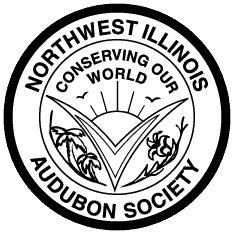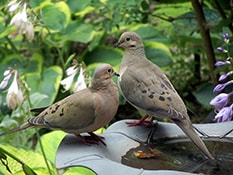
by NIAS | Aug 1, 2023 | Beginning Birder
Mourning Dove (Zenaida macroura)
Mourning Doves are a common bird in North America, related to Rock Pigeons. They can be found in a wide variety of habitats, including backyards. They are primarily seed eaters and will feed on the ground. They may visit bird feeders for any fallen seed, especially millet. They are often seen perching on telephone wires in pairs, easily recognized by their silhouette.
Mourning Doves have a small head with thin, black bills and a plump body. They have pale peach-colored feathers, with gray on top. There are scattered black spots on the wings with pink iridescence and sometimes a small black mark on the neck can be seen.
They are recognizable for their sad, mournful “coo coo” song that gives them their name. When in flight, they make loud whistling sounds and may clap their wings, which could help to scare a predator or give warnings to other birds.
After a Mourning Dove forms a pair bond for the breeding season, they will build a flimsy nest. Nests can be found typically in trees and grounds, but can also be formed in gutters and eaves of houses. They will lay two eggs, but multiple times during a breeding season.
To help protect Mourning Doves and any other bird, please leave your cats indoors. Ground-dwelling birds are easily caught and killed by cats. We can help birds by keeping our cats inside.
* Thanks to allaboutbirds.org.
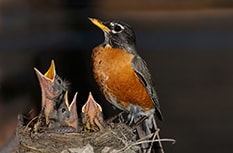
by NIAS | Aug 1, 2023 | Family Activity
Family Activity
What do birds eat and how do they eat it?
Look at some bird pictures and point out the beaks, explaining that every bird has a beak that is shaped to help it find and eat its own food. Then you can try out these techniques:
- Eat like a robin: Embed gummy worms in a pan full of dried oats. Have the child try to spear the gummy worms with tweezers.
- Eat like a hummingbird: Have the child suck up a little sugar water, using a straw for a beak and fitting the straw through a hole in a piece of paper or foil covering a glass.
- Eat like a cardinal: Use a nutcracker to crack sunflower seeds or something of similar hardness. Point out the wide, strong beak of the cardinal.
- Eat like a woodpecker: Help a child peck hard at an old piece of wood with a screwdriver or other hard, pointed object; an adult can help to make sure there are no injuries. Another idea is to take a paper towel roll poked with holes and put small pieces of gummy worms partially seen from the outside. The child has to pull the worm out through the hole, similar to what a woodpecker would do.
- Eat like a flycatcher or a swallow: Have the child catch some popped popcorn or light cereal that you throw into the air. For more fun, hang the food on a string and have them chase after the “fly” around the room.
- Eat like a finch: Put some rice cereal in a small cardboard box with holes in it; have them get the cereal out with tweezers.
- Eat like a chickadee/sparrow, etc.: Put the cereal in a bowl and let them eat – no hands allowed.
- Eat like an eagle, hawk, etc.: Let the child pounce on a small stuffed animal – you can add the predator/prey information if appropriate for age.
Family Activity
Explore the water!
Go with a parent or adult to a pond or creek. Bring a net, coffee can, bucket, or any other container. Don’t forget to wear boots and prepare to get wet!
Scoop up the water and make sure to gather a lot of the dirt at the bottom – some of the most interesting creatures are hiding down there! These creatures tend to be scavengers and detritivores, digesting dead material and returning them back to the water. They play an important role for the health of the aquatic ecosystem.
You may find invertebrates, such as dragonfly, damselfly, and mayfly larvae as well as adults of these larvae flying around. You may also see giant water bugs, water striders sliding along the surface of the water, diving beetles, water boatmen, and water scorpions. You may find larger invertebrates like a crayfish scurrying along the bottom. Be on the lookout for vertebrates such as minnows or larger fish, amphibians like frogs and toads, reptiles like turtles and snakes, and maybe even mammals swimming in the water!
Anything you collect, make sure to treat them with respect and care and put them back in the water when you are done.
Here is a cool resource created by entomologist Moriya Rufer from the University of Minnesota to help in identification!
Safety tips – make sure to use caution around slippery rocks. Algae or moss growing on a rock makes them slippery, so always check that you have secure footing. It’s best not to jump from rock to rock. Crayfish have some strong claws – be careful when handling them to avoid pinches! Similarly, be careful with some insects, especially the giant water bug – because they are predators, they can have a painful bite (they are nicknamed toe-biters!). A change of clothes for the trip back home is also helpful!
Explore
Summertime is a great time to explore aquatic ecosystems! On hot days, what better way is there than to cool off from the hot sun by playing in water. Go with a parent or other adult to a pond or creek and learn how to play safely near water. Bring a bucket, fish net or sandbox sifter, and large white bowls or plates when you go. If you have a magnifying lens, bring that too!
Wade into the water carefully, scoop out some water with the mud from the bottom (that will get you some fun creatures) and dump it into your white containers. The white background will allow you to see specimens better. Look for water bugs, larvae of dragonflies, damselflies, and mayflies, snails, mussels, crayfish and much more! Don’t forget to put them back into their home in the water when you are done!
For younger children – learn about the properties of water by using a big bowl of water and placing objects into it. For example, discuss how objects float and sink by placing rocks, flowers, leaves, and other things in nature.
Go Mothing!
Summer is an excellent time to search for moths. There are a few simple ways to find them. Moths tend to be attracted to lights, so an easy way to attract them is to turn on a porch light and bring them close. To see them better, hang a white sheet on a clothesline or wall and shine a light onto it. Then just wait and see.
You can also attract moths by providing a sugary food. Make “moth food” – mix, sugar and a fruit, such as banana or peach. Then spread it on a tree trunk and check back as the sun sets.
Learn more
Late Summer into Fall
As we approach fall time, a fun activity you can do is to make leaf rubbings. All you need is a piece of paper, your favorite crayon, and a leaf.
First, go outside and retrieve a leaf off a nearby tree. Next, lay your leaf down on a flat surface and put the sheet of paper over it. If your crayon has a wrapper on it, peel it off. Then using the long side of the crayon, shade on the paper over the leaf. You’ll be surprised to see that you have just drawn the leaf you picked out!
As summer comes to an end and the weather cools off slightly, a fun thing to do with your family is to have a campfire and roast s’mores! To make s’mores around a campfire, all you need is graham crackers, chocolate, marshmallows, and a stick.
First, put your marshmallow on the end of the stick. Hold the marshmallow over the fire until it is cooked just how you like it. Then, put a piece of chocolate on a graham cracker, and use another graham cracker to sandwich the chocolate and the marshmallow in the middle. Enjoy!

by NIAS | Apr 27, 2023 | Family Activity
Family Activity
Celebrate the theme of World Migratory Bird Day 2023
Celebrate the theme of World Migratory Bird Day 2023 about water by exploring aquatic ecosystems. All living organisms, including YOU, require water.
Put on some boots, bring some nets and containers, and of course, bring binoculars. Walk around aquatic habitats, such as near streams and creeks and search for creatures that rely on water. There are many bird species than tend to be near or on water, such as Sandhill Cranes, Red-winged Blackbirds, American White Pelicans, Great Blue Herons, and many species of waterfowl. Many migratory warblers and sparrows require water for survival on their long journeys. These birds use the habitat for shelter, food, and for their nests. See if you can observe the behavior of these birds by keeping distant and quiet. You may get a chance to see their nests and what they use for food. Water is a great place that attracts insects that many birds can eat.
When you have an opportunity, safely collect water samples from the creek (ensure an adult is with you and be careful in and near the water). What kind of organisms can you find in the water? Many invertebrates live in water including insects, their larvae, and crayfish. You may also find vertebrates in the water like amphibians and fish or mammals that live nearby.
When you return home, consider how you use water. Think about how often you use water or waste water and learn ways to conserve it, such as turning off the faucet while brushing teeth and not putting toxic materials down the drain.
Learn more about World Migratory Bird Day at migratorybirdday.org.
Let’s Get Ready for the Special Children’s Nature Walk
Can you guess which bird is identified below? Which of these can we find? Get out your bird books or go online and see if you can bring the identity of these birds with you when you come with us on the Special Children’s Nature Walk at Oakdale on May 24. These are birds we are likely to see that morning:
Bird A
- I have red on my wings.
- I like to be near water.
Bird B
- I like to live in the open, away from the trees.
- I like to eat mealworms.
Bird C
- I have a rosy-red breast.
- I just come through Oakdale on migration.
Bird D
- I have a dark gray back and red-brick breast.
- I like to eat worms.
Bird E
- I have a solid black cap, white cheeks and black throat.
- I am little and friendly.
Bird F
- I have a black head and upperparts, a white wing bar and bright orange underparts.
- I love to eat oranges!
How about this creature we might see?
- My eight simple eyes help me see to the front, behind, below, above and to the sides. I have eight legs too.
- I eat lots of insects, many of which carry diseases or are harmful to plants. I’m really not such a bad fellow.
Or we might find this one:
- I am able to breathe and drink through my moist skin.
- I have two webbed feet, four legs, two eyes and a backbone.
- I’m green and live in and out of water.
Backyard Feeding Tips to Attract the Baltimore Oriole
Jelly is one of the most effective oriole foods you can offer. Smooth grape jelly is best, but the birds will also take orange marmalade or red cherry, strawberry or raspberry jellies. Offer jelly in small dishes, in a hollow orange rind or smeared on an orange half and the orioles won’t be able to leave it alone. Do not, however, offer sugar free jellies; it is the sugar that gives the birds the necessary energy and calories they need. Ideally, organic jellies are best.
As the weather begins to warm up head out to your favorite trail to enjoy the spring weather and nature.
If the wind is strong, go outside and fly kites with your friends and family! If you do not own a kite already, then go to the store and purchase one before finding an open area outside to fly the kites in. Compete against your friends to see who can fly their kite the highest and longest!
An entertaining planting craft that you can do as a family is to make your own grass cups! All you need are cups, construction paper, scissors, tape, soil, and grass seed. First, start by cutting out silly faces from the construction paper, and tape them onto the cup. Put soil inside the cup, then plant the seeds inside. Water your grass daily, and watch it grow!
Fly like a Bird and Learn about Migration
Ask yourself: Why do birds fly over our town? Where do you think they are going and why? Birds may fly around for several reasons: to find a new home, to find food, to find water, or to seek shelter and safety. Then learn about migration, which is a longer distance flight. Spring is a time for many birds to migrate. Why do birds migrate? They might be looking for better food availability, breeding areas to find a mate, or better climate.
Learn about migration by playing migration games with your family. Have several family members or friends pretend to be a flock of migrating birds – perhaps in a “V” formation that geese do. Take turns being the leader of the V while the others make two angled lines. Follow the leader without bumping into each other and keeping the V formation – it’s tricky unless you communicate! Birds call to signal each other – you can make this fun by having the lead bird call back things like, “You getting too tired, Jack?” or “How are you doing, Jill?” or by making bird calls!
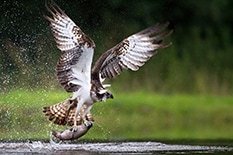
by NIAS | Apr 27, 2023 | Beginning Birder
Osprey (Pandion haliaetus)
This year’s theme for World Migratory Bird Day is water and the Osprey is one of the ten featured ambassador birds to help educate the importance of water to birds. Osprey are typically found near any body of water, from freshwater to marine. They are a unique in that they are the only hawk that feeds primarily on fish.
Ospreys are mostly brown on the upperparts and white on the underside. The adults have a brown eyeline stripe, yellow eyes, and a sharply hooked bill. They have slender bodies with narrow wings and long legs. They are easily identified in flight with their brown wrists and a kink in their wings, creating an M shape in flight. To catch their prey, they dive feet first into the water and often fully submerge (no more than three feet below surface) to grasp their prey. They have unique feet with a reversible outer toe, which allows them to hold on to their slippery prey with two toes in front and two in back.
Ospreys usually mate for life. Together they build very large nests and require a platform-like surface or similar placement. Humans can assist by providing nesting platforms in areas where Osprey breed. Ospreys are endangered or threatened depending on the state due to the use of DDT pesticides from the 1950s to 1970s. The pesticides poisoned the birds (as well as other species) and caused their eggshells to thin, leading to severe decline in populations. Today, their populations are improving but they are still at risk of entanglement and death due to plastic pollution that can be tangled in their nests.
* Thanks to allaboutbirds.org.
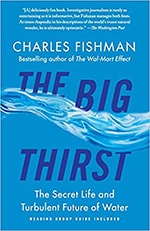
by NIAS | Apr 27, 2023 | Adult Books
The Big Thirst: The Secret Life and Turbulent Future of Water
by Charles Fishman

The author shares the reality of our relationship with water. We require it for life yet we so readily pollute and make it undrinkable without thinking of future consequences. Written in 2012, it describes many examples of water troubles, but the theme is still relevant to current events we see today. Access to water has been changing for years and it is time to consider the inevitability of a global water crisis.

